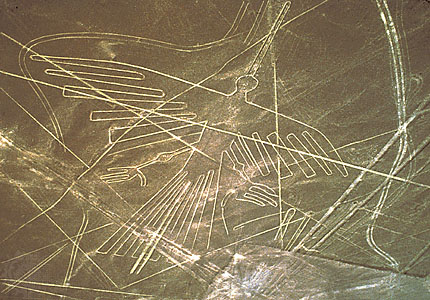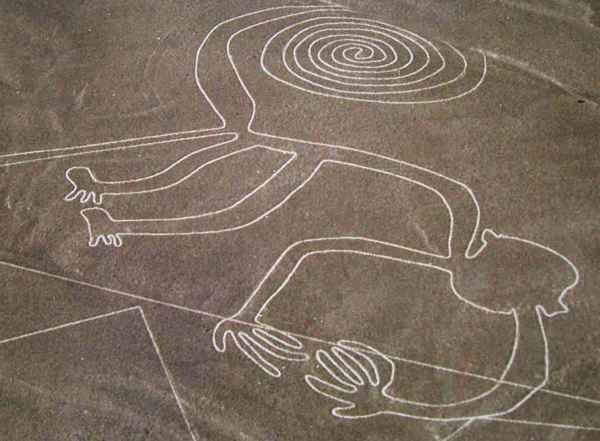Nazca Lines
The Nazca Desert is the southern part of Peru, not too far from the Pacific coast. The desert is an extremely dry area, close to windless, and has a temperature of roughly 75 degrees Fahrenheit year round. It is covered by pebbles coated in reddish-brown iron oxide with a white sublayer beneath it. By and large, the desert was considered otherwise non-descript until the early part of the twentieth century.
In 1927, that changed. A Peruvian archeologist named Toribio Mejia Xesspe was hiking in nearby foothills when he noticed something odd in Nazca — something which looked like a series of white lines drawn across the desert floor. His interest was merely a passing one, mentioning them here and there, most notably at a conference in 1939. A year or two after that, a historian from the U.S. named Paul Kosok took this to the next level — literally. He took to the sky, flying over the lines, and noted a bird — below.

The lines were not just lines. Some were shapes — carvings, of sorts, of animals, such as the bird (considered a condor) above and the monkey, below. The shapes are enormous — the largest figure stretches in the realm of 750 feet across, and the shapes cover an area of nearly 200 square miles.

The lines are roughly 1500 years old, created by a culture — the Nazca — which lived in the area between the years 400 and 650. They were most likely created using primitive surveying tools — in fact, wooden stakes have been found at the endpoints of some lines, and the stakes have been determined to date back to the period that the Nazca people were living in the area. The lines are actually four to six inch deep trenches over which the pebbles have been removed, exposing the white sublayer.
The Nazca Lines have been preserved due to the peculiarities of the environment — terrain in the dry, hot, and not at all windy desert rarely erodes. The sublayer contains a high percentage of lime which absorbs mist and hardens, making the lines particularly able to weather any exceptional changes to the surroundings. In total, hundreds of shapes and designs (very few of which are of animals) have been preserved for well over a millennium.
What purpose the lines served has been lost to antiquity. Some believe that the animal shapes have to do with something akin to astrology, but that seems to be a minority view. Another theory is that these were crude, enormous looms, used to make long and wide textiles. Yet another camp suggests that the lines act as an on-ground map to nearby water, be it for use by travelers or, more likely deities peering down from above. And of course, at least one person — Swiss author Erich von Daniken, generally considered nothing more than a pseudohistorian — is on record saying that the lines have something to do with aliens. The lines, he claims, were a series of runways used by extra terrestrials and later mistake by humans in the area to be gods. (Of course, a monkey-shaped runway would be rather weird, implying that apes and chimps were actually visitors from outer space.)
The consensus view is that the lines, whatever their specific purpose may be, served some sort of religious significance — and aliens were not at all involved.
Bonus fact: One author, a man named Jim Woodman, theorized that in order for the Nazca Lines to have been developed with such complex images, the Nazca people needed to get a bird’s-eye view of them — in other words, he argued, the Nazca knew how to fly. To demonstrate that it this was plausible, Woodman built a hot air balloon using materials and technology available to the Nazca. Nevertheless, his approach and conclusions have been widely panned, as seen, for example, here.
From the Archives: Mystery Tome: The Voynich Manuscript — a book of drawings and words which no one seems to understand.
Related: “Nazca: Journey to the Sun” by Jim Woodman. Published 35 years ago and long out of print, but some used copies are available for cheap.

Leave a comment